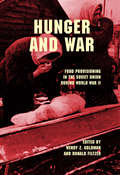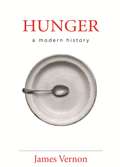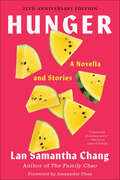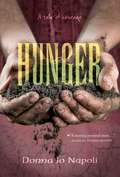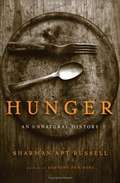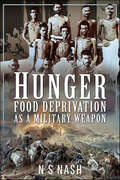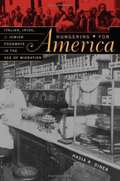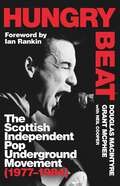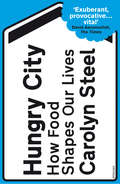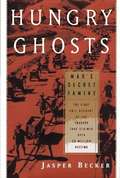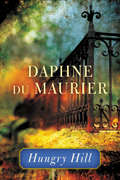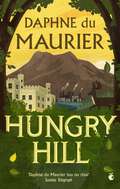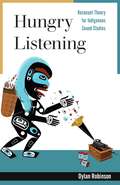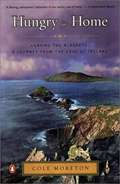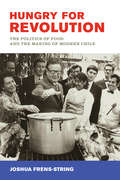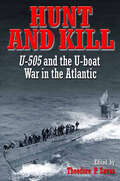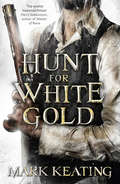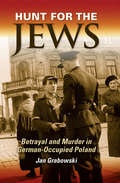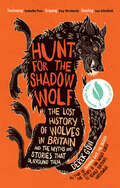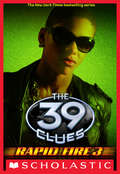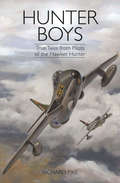- Table View
- List View
Hunger and War
by Donald A. Filtzer Wendy Z. GoldmanDrawing on recently released Soviet archival materials, Hunger and War investigates state food supply policy and its impact on Soviet society during World War II. It explores the role of the state in provisioning the urban population, particularly workers, with food; feeding the Red army; the medicalization of hunger; hunger in blockaded Leningrad; and civilian mortality from hunger and malnutrition in other home front industrial regions. New research reported here challenges and complicates many of the narratives and counter-narratives about the war. The authors engage such difficult subjects as starvation mortality, bitterness over privation and inequalities in provisioning, and conflicts among state organizations. At the same time, they recognize the considerable role played by the Soviet state in organizing supplies of food to adequately support the military effort and defense production and in developing policies that promoted social stability amid upheaval. The book makes a significant contribution to scholarship on the Soviet population's experience of World War II as well as to studies of war and famine.
Hunger: A Modern History
by James VernonHunger is as old as history itself. Indeed, it appears to be a timeless and inescapable biological condition. And yet perceptions of hunger and of the hungry have changed over time and differed from place to place. Hunger has a history, which can now be told. At the beginning of the nineteenth century, hunger was viewed as an unavoidable natural phenomenon or as the fault of its lazy and morally flawed victims. By the middle of the twentieth century, a new understanding of hunger had taken root. Across the British Empire and beyond, humanitarian groups, political activists, social reformers, and nutritional scientists established that the hungry were innocent victims of political and economic forces outside their control. Hunger was now seen as a global social problem requiring government intervention in the form of welfare to aid the hungry at home and abroad. James Vernon captures this momentous shift as it occurred in imperial Britain over the past two centuries. Rigorously researched, Hunger: A Modern History draws together social, cultural, and political history in a novel way, to show us how we came to have a moral, political, and social responsibility toward the hungry. Vernon forcefully reminds us how many perished from hunger in the empire and reveals how their history was intricately connected with the precarious achievements of the welfare state in Britain, as well as with the development of international institutions, such as the United Nations, committed to the conquest of world hunger. All those moved by the plight of the hungry will want to read this compelling book.
Hunger: A Novella and Stories
by Lan Samantha Chang“A masterwork of enormous power.” —Min Jin Lee, author of Pachinko The searing debut of “one of the most influential writers in American letters…Hunger is a masterpiece, a necessary haunting” (Justin Torres, author of We the Animals).A powerful exploration of the Asian American experience, Hunger weaves the forces of war and magic, food and desire, ghosts and family into poignant tales of love and loss. Celebrated author Lan Samantha Chang illuminates the lives of first-generation immigrants from China, culturally and emotionally uprooted from their homeland, who mistrust connection even as they hunger for attachment—and shows how their choices shape their children. The characters who inhabit this extraordinary collection, “a work of gorgeous, enduring prose” (Helen C. Wan, Washington Post), are caught between the burden of their past and the fragility of their unchartered future.
Hunger: A Tale of Courage
by Donna Jo NapoliThrough the eyes of twelve-year-old Lorraine this haunting novel from the award-winning author of Hidden and Hush gives insight and understanding into a little known part of history—the Irish potato famine. <P><P>It is the autumn of 1846 in Ireland. Lorraine and her brother are waiting for the time to pick the potato crop on their family farm leased from an English landowner. But this year is different—the spuds are mushy and ruined. What will Lorraine and her family do? Then Lorraine meets Miss Susannah, the daughter of the wealthy English landowner who owns Lorraine’s family’s farm, and the girls form an unlikely friendship that they must keep a secret from everyone. Two different cultures come together in a deserted Irish meadow. And Lorraine has one question: how can she help her family survive? <P><P> A little known part of history, the Irish potato famine altered history forever and caused a great immigration in the later part of the 1800s. Lorraine’s story is a heartbreaking and ultimately redemptive story of one girl’s strength and resolve to save herself and her family against all odds.
Hunger: An Unnatural History
by Sharman Apt RussellA subject as big as history and as everyday as skipping lunch -- how does hunger work? -- is explored in this thought-provoking, kaleidoscopic blend of science, anthropology, and personal reflection.
Hunger: Food Deprivation as a Military Weapon
by N. S. NashThroughout the ages, more combatants and civilians have died in war of the effects of starvation and resulting disease than have been killed by bullet or bomb. The author of this fascinating work argues that, over the last 160 years, conflicts have been decided not just on the battlefield but by the denial of an adversary’s access to food. The starvation that followed led to military indiscipline, social unrest, and a failure of governance. Numerous examples prove his point, not least Germany in 1919. The Union blockade of the Confederacy in 1861 was a major factor in the outcome of the Civil War as was the American strategy against Japan in 1943-1945. The fates of besieged forces both at Vicksburg in 1863 and the British at Kut in 1916 were sealed when control of their respective supply routes was lost. Churchill’s fears over Hitler’s U-boat campaign were well justified. ‘Logistics’ is a modern word, but it describes a fundamental element of generalship, amply demonstrated at Metz in 1870 when logistic illiteracy resulted in a vast and hitherto undefeated French army having no option but to surrender. This thought-provoking book vividly demonstrates that extreme hunger is the precursor to starvation and, consequently, almost inevitable defeat. It proves that deprivation of food is a potent weapon that no commander can ignore.
Hungering for America: Italian, Irish, and Jewish Foodways in the Age of Migration
by Hasia R. DinerMillions of immigrants were drawn to American shores, not by the mythic streets paved with gold, but rather by its tables heaped with food. How they experienced the realities of America's abundant food--its meat and white bread, its butter and cheese, fruits and vegetables, coffee and beer--reflected their earlier deprivations and shaped their ethnic practices in the new land. Hungering for America tells the stories of three distinctive groups and their unique culinary dramas. Italian immigrants transformed the food of their upper classes and of sacred days into a generic "Italian" food that inspired community pride and cohesion. Irish immigrants, in contrast, loath to mimic the foodways of the Protestant British elite, diminished food as a marker of ethnicity. And, East European Jews, who venerated food as the vital center around which family and religious practice gathered, found that dietary restrictions jarred with America's boundless choices. These tales, of immigrants in their old worlds and in the new, demonstrate the role of hunger in driving migration and the significance of food in cementing ethnic identity and community. Hasia Diner confirms the well-worn adage, "Tell me what you eat and I will tell you what you are. "
Hungering for America: Italian, Irish, and Jewish Foodways in the Age of Migration
by Hasia R. DinerMillions of immigrants were drawn to American shores, not by the mythic streets paved with gold, but rather by its tables heaped with food. How they experienced the realities of America’s abundant food—its meat and white bread, its butter and cheese, fruits and vegetables, coffee and beer—reflected their earlier deprivations and shaped their ethnic practices in the new land. Hungering for America tells the stories of three distinctive groups and their unique culinary dramas. Italian immigrants transformed the food of their upper classes and of sacred days into a generic “Italian” food that inspired community pride and cohesion. Irish immigrants, in contrast, loath to mimic the foodways of the Protestant British elite, diminished food as a marker of ethnicity. And East European Jews, who venerated food as the vital center around which family and religious practice gathered, found that dietary restrictions jarred with America’s boundless choices. These tales, of immigrants in their old worlds and in the new, demonstrate the role of hunger in driving migration and the significance of food in cementing ethnic identity and community. Hasia Diner confirms the well-worn adage, “Tell me what you eat and I will tell you what you are.”
Hungry Beat: The Scottish Independent Pop Underground Movement (1977-1984)
by Douglas MacIntyre Grant McPhee'Hungry Beat is the story of an all-too-brief era where the short-circuiting of that industry seemed viable. But hell, the times were luminous as was the music these artists made. The songs and many of the players remain, and here they tell their story and lick their wounds' Ian RankinThe immense cultural contribution made by two maverick Scottish independent music labels, Fast Product and Postcard, cannot be underestimated. Bob Last and Hilary Morrison in Edinburgh, followed by Alan Horne and Edwyn Collins in Glasgow helped to create a confidence in being Scottish that hitherto had not existed in pop music (or the arts in general in Scotland). Their fierce independent spirit stamped a mark of quality and intelligence on everything they achieved, as did their role in the emergence of regional independent labels and cultural agitators, such as Rough Trade, Factory and Zoo.Hungry Beat is a definitive oral history of these labels and the Scottish post-punk period. Covering the period 1977-1984, the book begins with the Subway Sect and the Slits performance on the White Riot tour in Edinburgh and takes us through to Bob Last shepherding the Human League from experimental electronic artists on Fast Product to their triumphant number one single in the UK and USA, Don't You Want Me. Largely built on interviews for Grant McPhee's Big Gold Dream film with Last, Hilary Morrison, Paul Morley and members of The Human League, Scars, The Mekons, Fire Engines, Josef K, Aztec Camera, The Go-Betweens and The Bluebells, Hungry Beat offers a comprehensive overview of one of the most important periods of Scottish cultural output and the two labels that changed the landscape of British music.
Hungry Beat: The Scottish Independent Pop Underground Movement (1977-1984)
by Douglas MacIntyre Grant McPhee'Hungry Beat is the story of an all-too-brief era where the short-circuiting of that industry seemed viable. But hell, the times were luminous as was the music these artists made. The songs and many of the players remain, and here they tell their story and lick their wounds' Ian RankinThe immense cultural contribution made by two maverick Scottish independent music labels, Fast Product and Postcard, cannot be underestimated. Bob Last and Hilary Morrison in Edinburgh, followed by Alan Horne and Edwyn Collins in Glasgow helped to create a confidence in being Scottish that hitherto had not existed in pop music (or the arts in general in Scotland). Their fierce independent spirit stamped a mark of quality and intelligence on everything they achieved, as did their role in the emergence of regional independent labels and cultural agitators, such as Rough Trade, Factory and Zoo.Hungry Beat is a definitive oral history of these labels and the Scottish post-punk period. Covering the period 1977-1984, the book begins with the Subway Sect and the Slits performance on the White Riot tour in Edinburgh and takes us through to Bob Last shepherding the Human League from experimental electronic artists on Fast Product to their triumphant number one single in the UK and USA, Don't You Want Me. Largely built on interviews for Grant McPhee's Big Gold Dream film with Last, Hilary Morrison, Paul Morley and members of The Human League, Scars, The Mekons, Fire Engines, Josef K, Aztec Camera, The Go-Betweens and The Bluebells, Hungry Beat offers a comprehensive overview of one of the most important periods of Scottish cultural output and the two labels that changed the landscape of British music.
Hungry City: How Food Shapes Our Lives
by Carolyn Steel'Cities cover just 2% of the world’s surface, but consume 75% of the world’s resources’.The relationship between food and cities is fundamental to our everyday lives. Food shapes cities and through them it moulds us - along with the countryside that feeds us. Yet few of us are conscious of the process and we rarely stop to wonder how food reaches our plates. Hungry City examines the way in which modern food production has damaged the balance of human existence, and reveals that we have yet to resolve a centuries-old dilemma - one which holds the key to a host of current problems, from obesity and the inexorable rise of the supermarkets, to the destruction of the natural world.Original, inspiring and written with infectious enthusiasm and belief, Hungry City illuminates an issue that is fundamental to us all.
Hungry Ghosts: Mao's Secret Famine
by Jasper BeckerIn the late 1950s and early 1960s, the Chinese people suffered the worst famine in history. This is the first full account of this dark chapter in Chinese history, which reveals state-sponsored terror, cannibalism, torture, and murder.
Hungry Hill
by Daphne Du MaurierA novel about 5 generations of a landed Irish family, the Brodericks.
Hungry Hill (Virago Modern Classics #115)
by Daphne Du MaurierFROM THE BESTSELLING AUTHOR OF REBECCA'Daphne du Maurier has no rival' SUNDAY TELEGRAPH 'du Maurier is a magician, a virtuouso' GOOD HOUSEKEEPING 'A storyteller of cunning and genius' SALLY BEAUMAN 'I tell you your mine will be in ruins and your home destroyed and your children forgotten . . . but this hill will be standing still to confound you.The Brodricks of Clonmere gain great wealth by harnessing the power of Hungry Hill and extracting the treasure it holds. The Donovans, the original owners of Clonmere Castle, resent the Brodricks' success and consider the great house and its surrounding land theirs by rights.For generations the feud between the families has simmered, always threatening to break into violence . . .
Hungry Hill (Vmc Ser. #512)
by Daphne du MaurierHungry Hill is a passionate story told with du Maurier's unique gift for drama. It follows five generations of an Irish family and the copper mine on Hungry Hill to which their fortunes and fates are so closely bound.
Hungry Listening: Resonant Theory for Indigenous Sound Studies (Indigenous Americas)
by Dylan RobinsonWInner of the Best First Book from the Native American and Indigenous Studies Association Winner of the Labriola Center American Indian National Book Award Winner of the Ann Saddlemyer Award from the Canadian Association for Theatre ResearchReimagining how we understand and write about the Indigenous listening experienceHungry Listening is the first book to consider listening from both Indigenous and settler colonial perspectives. A critical response to what has been called the &“whiteness of sound studies,&” Dylan Robinson evaluates how decolonial practices of listening emerge from increasing awareness of our listening positionality. This, he argues, involves identifying habits of settler colonial perception and contending with settler colonialism&’s &“tin ear&” that renders silent the epistemic foundations of Indigenous song as history, law, and medicine. With case studies on Indigenous participation in classical music, musicals, and popular music, Hungry Listening examines structures of inclusion that reinforce Western musical values. Alongside this inquiry on the unmarked terms of inclusion in performing arts organizations and compositional practice, Hungry Listening offers examples of &“doing sovereignty&” in Indigenous performance art, museum exhibition, and gatherings that support an Indigenous listening resurgence.Throughout the book, Robinson shows how decolonial and resurgent forms of listening might be affirmed by writing otherwise about musical experience. Through event scores, dialogic improvisation, and forms of poetic response and refusal, he demands a reorientation toward the act of reading as a way of listening. Indigenous relationships to the life of song are here sustained in writing that finds resonance in the intersubjective experience between listener, sound, and space.
Hungry Tiger: Encounters Between Hungarian and Bengali Literary Cultures
by Imarai BanghaStudy with special reference to influence of Rabindranath Tagore, 1861-1941 and his association with Hungary.
Hungry for Home: A Journey from the Edge of Ireland
by Cole MoretonMoreton delivers this beautiful, haunting, previously untold story of a vanished people from the edge of Ireland and the events that led to the abandonment of their way of life. This book is about home and what that means and a gripping account of the quest for a vanished people. [From the back cover:] "On Christmas Eve, 1946, a young man collapsed on a remote island off the coast of Ireland. There was no priest, no doctor, and no policeman on the Great Blasket, and no contact with the outside world. Helpless, his family watched him die. Cole Moreton's Hungry for Home tells the story of an Irish island, whose inhabitants lived a medieval way of life and spoke a pure form of Irish, until the dramatic events that led to its being abandoned. Searching for the islanders who had left half a century earlier, Moreton seeks out the dead man's brothers and finds them in America. This is a book about home and what that means, but most of all it is a story of a family and their breathtaking journey from one way of life to another." The author tells the story he learned from articles and books, but most importantly from the last islanders themselves. Cole Moreton spent years exploring the remains of the village on the Blasket Island, making land and sea journeys as it's people did, tracing their path to reside on Mainland Ireland and across the Atlantic to the United States. As he visits former islanders, whose children have become quite Americanized, he discovers that the Blasket community reassembled itself in Connecticut in an area they named Hungry Hill. Excerpts of books written by islanders, and accounts of their work, stories, loves and losses are revealing and moving, and as the author admits, often edited by the tellers to cast their former Blasket home and way of life in the best possible light. Here is the story of the crumbling of a centuries old culture. A list of family names, list of illustrations, and a useful bibliography are included.
Hungry for Revolution: The Politics of Food and the Making of Modern Chile
by Joshua Frens-StringHungry for Revolution tells the story of how struggles over food fueled the rise and fall of Chile's Popular Unity coalition and one of Latin America's most expansive social welfare states. Reconstructing ties among workers, consumers, scientists, and the state, Joshua Frens-String explores how Chileans across generations sought to center food security as a right of citizenship. In so doing, he deftly untangles the relationship between two of twentieth-century Chile's most significant political and economic processes: the fight of an emergent urban working class to gain reliable access to nutrient-rich foodstuffs and the state's efforts to modernize its underproducing agricultural countryside.
Hunt and Kill: U-505 and the Battle of the Atlantic
by Theodore P. SavasOne of WWII's pivotal events was the capture of U-505 on June 4, 1944. The top secret seizure of this massive Type IX submarine provided the Allies with priceless information on German technology and innovation. After the war U-505 was transported to Chicago, where today 1,000,000 visitors a year pass through her at the Museum of Science and Industry. Hunt and Kill offers the first definitive study of U-505. The chapters cover her construction, crew and commanders, combat history, general Type IX operations, naval intelligence, the eight fatal German mistakes that doomed the boat, and her capture, transportation, and restoration for posterity. The contributors to this fascinating volume--a Who's Who of U-boat historians--include: Erich Topp (U-Boat Ace, commander of U-552); Eric Rust (Naval Officers Under Hitler); Timothy Mulligan (Neither Sharks Nor Wolves); Jak Mallman Showell (Hitler's U-boat Bases); Jordan Vause (Wolf); Lawrence Patterson (First U-boat Flotilla); Mark Wise (Enigma and the Battle of the Atlantic); Keith Gill (Curator, Museum of Science and Industry), and Theodore Savas (Silent Hunters; Nazi Millionaries).
Hunt for White Gold
by Mark KeatingSold by his father for four guineas, Patrick Devlin was working as a servant to Royal Navy Captain John Coxon when he was catpured by pirates. Now, Devlin has himself become one of the most feared pirates in the world - and Coxon his most bitter foe. But in this thrilling new historical adventure it is not gold that Devlin is chasing, but something even more valuable. The early 18th Century is obsessed with the flavours of the New World - coffee and chocolate. And only one material enables the kings, queens and rising middle classes of Europe to drink without burning their fingers on the handles of their cups - Chinese porcelain. In a brilliant conspiracy story reaching from the unknown empires of the East to the restless new colonies of America, a letter has gone missing. In the letter lies the formula for the manufacture of Chinese porcelain, and whoever can find the letter can name his price - and even change the course of history, by enriching the nation that owns the secret. Valentim Mendes, a Portugese noble who has crossed swords with Devlin before, now seeks to blackmail him into finding the letter. And wherever Devlin goes, his nemesis Coxon is never far behind.
Hunt for the Jews: Betrayal and Murder in German-Occupied Poland
by Jan GrabowskiA revealing account of Polish cooperation with Nazis in WWII—a &“grim, compelling [and] significant scholarly study&” (Kirkus Reviews). Between 1942 and 1943, thousands of Jews escaped the fate of German death camps in Poland. As they sought refuge in the Polish countryside, the Nazi death machine organized what they called Judenjagd, meaning hunt for the Jews. As a result of the Judenjagd, few of those who escaped the death camps would survive to see liberation. As Jan Grabowski&’s penetrating microhistory reveals, the majority of the Jews in hiding perished as a consequence of betrayal by their Polish neighbors. Hunt for the Jews tells the story of the Judenjagd in Dabrowa, Tarnowska, a rural county in southeastern Poland. Drawing on materials from Polish, Jewish, and German sources created during and after the war, Grabowski documents the involvement of the local Polish population in the process of detecting and killing the Jews who sought their aid. Through detailed reconstruction of events, &“Grabowski offers incredible insight into how Poles in rural Poland reacted to and, not infrequently, were complicit with, the German practice of genocide. Grabowski also, implicitly, challenges us to confront our own myths and to rethink how we narrate British (and American) history of responding to the Holocaust&” (European History Quarterly).
Hunt for the Shadow Wolf [US Edition]: The lost history of wolves in Britain and the myths and stories that surround them
by Derek Gow"Terrific, life-lit moments come howling out of Hunt for the Shadow Wolf."—The Telegraph "[Derek Gow is] a wry, profane truth teller who is equal parts yeoman farmer, historical ecologist, and pirate."—Ben Goldfarb, author of Eager and Crossings "Beautifully crafted, fascinating and unbearably poignant, I totally loved this book."—Isabella Tree, author of Wilding Renowned rewilder Derek Gow has a dream: that one day we will see the return of the wolf to Britain as it has already returned elsewhere. As Derek worked to reintroduce the beaver, he began to hear stories of the wolf, both real and mythical, and his fascination with this creature grew. With increasing curiosity, Derek started to piece together fragments of information, stories and artefacts to reveal a shadowy creature that first walked proud through these lands and then was hunted to extinction as coexistence turned to fear, hatred – and domination. What Derek came to realize was that the underlying motives behind our hatred were actually far more prosaic and, like most persecutions, to do with power and profit. We turned the wolf into a savage beast and saw its extirpation as a civilizing mission. But the wolf survived far longer than many thought and Derek tells of his sightings of the wolf through folklore and mythology, the records of grand estates and parish churches as well as wolf heads, both real and recreated. With bitingly funny but also tender stories, Hunt for the Shadow Wolf is Derek’s quest to uncover the true nature of this creature because, as we seek to heal our landscape, we must reconcile our relationship with it. Before we can even begin to bring the wolf back, we need to understand it. "I have loved this chase dearly and though what unfolds might be an ending of sorts, I have no intention to let this hunt cease."―Derek Gow, from Hunt for the Shadow Wolf "Gow reinvents what it means to be a guardian of the countryside."—The Guardian
Hunted (The 39 Clues: Rapid Fire #3)
by Clifford RileyThe third of seven brand new 39 Clues stories, leading up to one explosive reveal. The Vespers are looking for new recruits and have targeted a few candidates: the Cahill children on the hunt for The 39 Clues. Uncover the Vespers' chilling plan to monitor the Kabras, the Holts, Jonah, and the Starlings, and learn who they picked as the most promising Vesper . . . and future Cahill traitor.
Hunter Boys: True Tales from Pilots of the Hawker Hunter (The\jet Age Ser. #2)
by Richard Pike&“Entertaining and informative tales of success, heroics, fear, relief and exhilaration in and around the Hunter cockpit&” (Royal Air Force Historical Society Journal). From the author of Lightning Boys, this is a fascinating look at the experiences of those who flew the iconic Hawker Hunter. Fifteen aircrew relate their individual recollections of the highs and lows, the dramas and demands of this incredible aircraft, which came into service in July 1951 and changed the future of fighter development. Included are a chapter by Neville Duke, Hawker Aircraft&’s chief test pilot, and other tales recounting the Aden emergency, the 1971 Indo-Pakistan war, and a race against the odds in Gibraltar. These true stories demonstrate the exceptional performance of this aircraft and illustrate its renowned lengthy service with the RAF and internationally—brought to life with original photographs plus paintings by acclaimed aviation artist Chris Stone.
